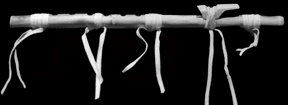Native
American Flutes, stories, and history
 A Yuma flute player, photographed about 1885. He is playing a cane flute.
This demonstrates that the flute, while not common among all Nations, did indeed stretch
from the west to the east. The majority of the flute music heard in the contemporary world
comes from the Plains Peoples, in terms of how the flute is made, and the modes of
tunings, fingerings, and style.
A Yuma flute player, photographed about 1885. He is playing a cane flute.
This demonstrates that the flute, while not common among all Nations, did indeed stretch
from the west to the east. The majority of the flute music heard in the contemporary world
comes from the Plains Peoples, in terms of how the flute is made, and the modes of
tunings, fingerings, and style.
There are many stories among the various Nations as to the origin
of the flute. Some American historians believe that the flute was developed after German
organ-pipe craftsmen came to America in search of woods with which to make organ pipes.
Given that these craftsmen did not arrive in America until the late 1700's, this could not
be a plausible theory, as indigenous flutes dating back nearly 2000 years have been
discovered by archeologists.
The flute was used by some Nations in ceremony or healing at
one time, but it has been said by the Elders that these ceremonies have been
removed from the People for a period of time. The flute's primary purpose was to be used
as a courting instrument for young men's use only. Traditionally, women never would touch
a flute. Many contemporary flute players still prefer this to be the case. However,
various Nations having different customs, there are now several female flute players. The
Elders tell that a woman is so powerful, that even her touch could destroy a flute's
special ability to win the heart of the one it was played for.
The flute came to the People by way of a young man who had
nothing. He fell in love with a girl whose father was a leader, a man among men. As the
young man had nothing, he could offer the girl and her family nothing, meaning he could
not even speak to her. He ran up a hill, sat beneath a tree, and began crying. The wind
felt sorry for the young man, and began to gently blow around him, so as to dry his tears.
A woodpecker began pecking at a tree branch above the young man's head. Although it was
irritating, the young man did his best to ignore the woodpecker. Soon, the wind began to
blow through the holes pecked in the tree branch. The branch fell from the tree, and the
young man recognized the gift that he had been given. As he walked down the hill, a bull
elk challenged the young man. The elk sang his love song to the cows when he realized that
the young man posed no threat., and the young man learned to play this song on his flute.
That night, he sat down behind the lodge of the girl he loved, and played this song. For 4 nights, he did this, and he knew that the young
woman he desired was listening, as no one came out of the lodge to chase him away. On the
fifth day, he followed the young woman to the stream where she went to get water each
morning. He hid in the bushes, and played his song. When she turned, he stood, showing
himself for the first time. He told her, "I know I am not much to see, and I have
nothing to offer you but my self. I will protect you and provide for you if you will have
me. But if you can look at me and tell me that you are not in love with the song that my
heart makes for you, then I will leave you and say no more". Of course, the young
woman was indeed taken by his song, as songs are very powerful when they are sung
correctly. And the young couple became the first to come together because of the flute.
WHO IS KOKOPELLI??  ********
********  *****
*****
Kokopelli is a flute player, a vagabond with a pack on his back,
a lover, a coward, and an overused image of the southwest art culture, depending on which
opinion you choose to accept. His figure appears in Hohokam and Fremont petroglyphs, and
the stories of his wanderings are many. Some say he is not a fluteplayer at all, but an
image of a traveling man. They say that the stick he holds is not a flute at all, but
rather a cane for traveling with. Some say that the stick is to hold a bag over his
shoulder, but this would be highly uncommon for an indigenous person to travel with such a
pack. Most Fremont, Hohokam, and Anasazi drawings and historical finds would indicate a
'tump' line (a band running over the forehead, to the top of the bag or basket, leaving
the hands free) or a dog pack.
His name most likely is an amalgam of Hopi and Zuni word for a
god, "Koko", and the word for an insect, "pelli". Some believe he was
a black man who led the Spanish through the Southwest in their search for Cibola. Some
Kokopelli figures on rocks are highly phallic, while others do not contain such
embellishments. Many petroglyphs did not originally contain phalluses, but were later
added by Spanish conquistadores, setting an early trend for graffiti. However the origin
of his extremity is from indigenous cultures, not from the Spanish. Many cultures have
believed that hunchbacks were fertility symbols, and this furthers that idea. In any
event, Kokopelli was always welcome at corn time, or when the men left for long periods,
so long as the men did not know he was lurking about.....
Nevertheless, his mystical and mythical figure has spawned many
legends, most of them contemporary and to be taken with a grain of salt. Only the Pueblo
People have the original stories of this legendary person, although many books have been
written about him and his prowess with the female gender. Regardless of the cultural view
of the Native flute, it seems to always be seen as a means of winning over a woman's
heart. Many would say that the flute still holds that power today.
THE FLUTE IN CONTEMPORARY CULTURE
The Native flute is the only melodic wind instrument belonging to
the People of this continent. There are some that believe that the flute should be
preserved exclusively as a cultural instrument, and still others that believe that access
should be granted to all who enjoy it's beautiful tones. Certainly, the resolve for both
sides lies somewhere in the middle.The arguments surrounding the cultural views have
merit, as contemporary times seem to allow non-Natives to simply 'steal' what they wish
from Native culture, without regard to context or concern for personal injury, spiritual
or otherwise. Therefore, the flute should be respected as the cultural icon that it is.
However, as the instrument grows in popularity, and is heard in many forms of music today,
it is obvious that the groundswell of aspiring flutists cannot be stopped. The issue is
similar to when the violin became available to the 'lower classes' in Italy during the
Dark Ages. The ruling classes felt that in the hands of the 'working classes', the value
of the violin would be diminished, and eventually become a toy for children. There was
much outcry among the politicoes of the time, much as there is today surrounding the
flute. As a flutist involved with children, I see the flute as a tool for all peoples to
use in a positive manner. There will always be those not respectful of the instrument for
it's cultural value, and this is distressing. However, the benefits to the large number of
children and adults alike that enjoy the flute far outweigh the numbers of those who would
not understand the flute as more than just a piece of wood. Therefore, it has been
proposed that Native flutes replace the plastic recorders that most 4-5 grade students
recieve during their music units in school. The flute will not only give them a sense of
music, but also a sense of cultural awareness. Student flutes are available from Eagle Crafts with costs beginning around $10.00 for a
quality, beginning instrument. A helpful video guide with Douglas Spotted Eagle is
available as well.
 **********
********** 
Fox Courting Flute Circa 1880's **************Seminole Cane
flute circa 1980
Instructions for making each of these flutes may
be found in the "VOICES OF NATIVE AMERICA/MUSIC AND
INSTRUMENTS" book. Also, instructional video, flutes, and more information may be
found at Scott Loomis' website. Flute music and
other Native American music may be ordered from Sound of
America Records, 1-800-890-SOAR. Also here is
a site that has some good, ( though not entirely accurate) information on flutes)
audiopage touring
touring music
music books
books  Voices of Native America
Voices of Native America photoalbum
photoalbum  links
links e-mail
e-mail

A Yuma flute player, photographed about 1885. He is playing a cane flute. This demonstrates that the flute, while not common among all Nations, did indeed stretch from the west to the east. The majority of the flute music heard in the contemporary world comes from the Plains Peoples, in terms of how the flute is made, and the modes of tunings, fingerings, and style.
 *****
*****
 **********
********** 